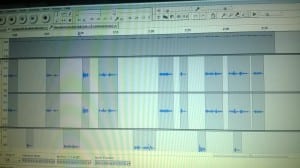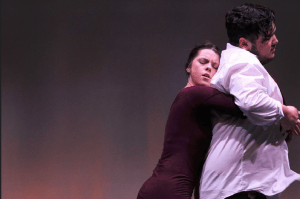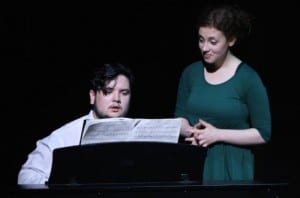As part of the role of a sound designer, my job is to edit the sound files. Below is a picture of the separate sound files I uploaded to Audacity which I recorded using a Auna mic 900b USB Cardioid studio condenser mic. One of the top tips for editing sound and music is, ‘if the tracks are available, lay down each effect on its own track’ (Kaye and LeBrecht, 2009, 112). So I cut each individual recording of the five separate voices into their own track to layer and overlap each other.

The reason each track is layered on top of each other is to reflect the build-up of anguish and tension between the wife and husband (Kirsty and Michael) which was shown through the increasingly distressed physical theatre presented on stage.

Lots of factors had to be taken into consideration when recording vocals; the proximity to the mic, the consistency between recording different voices, volume and noise control within the room. I also edited together the voice recording of Michael at the beginning of the ribbon sequence. Sound Designer Ross Brown talks about how sound files can be used ‘to create a mood in the audience so that they interpret the narrative or scene in a different way’ (Brown, 2010, 145). The reason the voice over sounds quite fragmented is because I want to reflect to the audience the sense of disjointed, jumbled thoughts that are going on in his brain, as he tries to comprehend what the doctor is telling him about Encephalitis.

Above is a picture taken from our final performance, where Michael slowly begins to remember his music again, and regains the memories of playing the piano. Music is chosen on the whole as an underscore to compliment the scene. If the levels of music are not correct, it could be ‘distracting the audience and detracting from the performance of the actor’ (Leonard, 2001, 121). This is why the director and I have made an executive decision to use only instrumental music because we did not want lyrics to detract the audience’s attention from the content of the scene. Overall, I am very proud of the final performance we have achieved as a Theatre Company. It raised awareness for Encephalitis, it spoke to each audience member individually and although the overall performance was subtle and understated, this worked to our advantage in telling a story of love, music and memory loss.
-Naomi
Works cited
Brown, R. (2010) Sound: A reader in theatre practice. Basingstoke: Palgrave Macmillan.
Kaye, D. and LeBrecht, J. (2009) Sound and Music for the Theatre: The Art and Technique of Design. Oxford: Elsevier.
Leonard, J. A (2001) Theatre Sound. London: A and C Black (Publishers) Limited.
Levitin, J. D (2006) This is your brain on music. London: Penguin Books Ltd.
Leave a comment